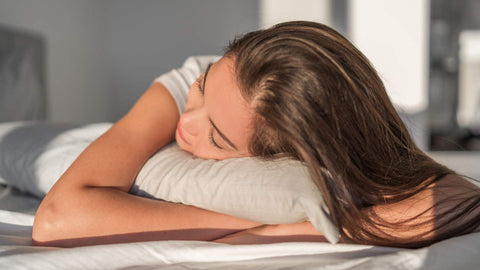Side sleeping is a popular and beneficial sleep position chosen by many. If you're a side sleeper, you're in good company - approximately 74% of people prefer this position. Side sleeping can reduce snoring, alleviate back pain, and improve brain health by efficiently clearing waste.
To maximize the benefits of side sleeping, it's essential to maintain proper alignment. Ensure your chin and neck are centered with your shoulders, and your shoulders are in line with your hips. Using a medium-firm mattress can provide the right balance of support and comfort for side sleepers.
Consider placing a pillow between your knees to relieve pressure on your hips and lower back. This simple adjustment can significantly enhance your sleep quality. Body pillows are another helpful tool for side sleepers, offering additional support and comfort throughout the night.
The Science of Side Sleeping
Side sleeping impacts your body in complex ways, affecting everything from spinal alignment to organ function. Understanding these effects can help you optimize your sleep position for better health and comfort.
Anatomical Considerations for Side Sleepers
When you sleep on your side, your spine naturally curves. This position can maintain proper spinal alignment if supported correctly. Your hips and shoulders bear most of your body weight, potentially causing pressure points.
To mitigate this, use a mattress that allows your hips and shoulders to sink in slightly while supporting your waist. A pillow between your knees can help align your hips and reduce lower back strain.
Your choice of pillow is crucial for neck support. It should fill the space between your ear and shoulder, keeping your neck in line with your spine.
Health Benefits and Concerns
Side sleeping offers several health advantages. It can reduce snoring and symptoms of obstructive sleep apnea by keeping your airways more open. This position may also improve brain health by facilitating the removal of waste products.
Sleeping on your left side can aid digestion and reduce acid reflux. It may also boost circulation, particularly beneficial during pregnancy.
However, side sleeping isn't without drawbacks. It can exacerbate shoulder pain and potentially contribute to wrinkles due to facial compression. Some people may experience numbness or tingling in their arms.
To minimize these issues, alternate sides and use supportive pillows. If you experience persistent discomfort, consult a doctor for personalized advice.
Optimizing Your Sleep Environment
Creating an ideal sleep setup can significantly enhance comfort and support for side sleepers. The right combination of mattress, pillows, and positioning aids can alleviate pressure points and promote proper alignment.
Choosing the Right Mattress and Pillow
A medium-firm mattress often works best for side sleepers. It provides enough cushioning to relieve pressure on hips and shoulders while supporting spinal alignment. Memory foam or hybrid mattresses can contour to your body's curves effectively.
For pillows, look for options that fill the gap between your head and the mattress. A pillow with a higher loft under your head helps keep your spine straight. Consider a contoured pillow designed specifically for side sleepers to support your neck.
To alleviate pressure on your lower back and hips, place a thin pillow between your knees. This helps maintain proper hip alignment and reduces strain on your lower spine.
Additional Equipment and Positional Tips
Body pillows can be excellent tools for side sleepers. Hug one to your chest to support your upper arm and place it between your knees for hip alignment. This can help reduce shoulder and back pain.
Try sleeping in the fetal position with your knees slightly bent. This posture can ease pressure on your back and potentially reduce snoring. Avoid tucking your chin to your chest, as this can strain your neck.
For pregnant women, a pregnancy pillow can provide crucial support for the abdomen and help alleviate discomfort. Place it under your belly and between your knees for optimal comfort.
If you experience acid reflux, try sleeping on your left side. This position can help reduce GERD symptoms by keeping your stomach below your esophagus, potentially minimizing acid backflow.



